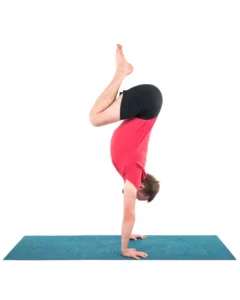Teaching Yoga: Why Do Students Leave, and Why Do They Stay?

Article At A Glance
Teaching yoga isn’t a popularity contest, it’s a vocation—one that can be full of lessons. For me, one of the big ones was embracing the reality that some people need different things at different times in their lives, and that has nothing to do with me or my competence as a yoga teacher. Competence is important of course, but it’s a different issue. The ability to shift focus away from people who don’t value what you do toward people who do value it is essential for successful teaching, and can be incredibly liberating.
I inherited a class at an upscale fitness center from a yoga teacher who was leaving town. She was a firecracker—hilarious, strong, and precise. She was known for teaching vigorous flow and not pulling punches. I knew taking over for her wasn’t a perfect fit for me, but I was hungry for more chances to teach. She warned me about a person who would probably drop out, saying that she’d told her she didn’t think my teaching would be challenging enough.
The student showed up for a few classes. She was tall and wiry with short, graying hair, simple black-framed glasses, and an athletic body. However, she didn’t last long; she dropped out after just a few weeks. I’ll admit I felt defeated and deflated.
A few weeks later, another person said she missed the previous teacher and asked me to pick up the pace. She told me she ran five miles daily and loved hard yoga workouts. She also admired me because “I think it’s great when people who are 10 to 15 pounds overweight hold themselves with so much composure.” After a few weeks, she was gone too. No surprises there.
Why Do Students Leave, and Why Do They Stay?

But while I was stressing out about losing those two because of my shortcomings, something more important was happening in the rest of the class: they kept coming back. Slowly, over time, more people started joining us, even some dedicated athletes who told me, my classes helped them bring balance to their strong exercise routines.
Psychologist Rick Hanson likes to say, “The brain is like Velcro for negative experiences, but Teflon for positive ones.” It’s so easy to remember the sting of those who’ve dropped out. And it’s even easier to make up stories about why and to interpret their actions as a reflection of your inadequacies.
So, I had to practice the alchemy of turning Teflon into Velcro. And I did this by shifting my gaze away from caring about why some folks leave and toward caring about those who didn’t. Like the person who told me that she got through her mother’s illness and death because of my classes, the one who stopped drinking and saved her marriage, and the one who started playing with her grandchildren because her back didn’t hurt anymore and on and on and on.
When I focus on being present for and supporting the people who return, I am a much better and more confident teacher. It’s also a huge relief. Thank goddess, I don’t have to be everyone’s yoga teacher.
Teaching Yoga: Liberate Yourself from Needing to Please Everyone
Teaching yoga isn’t a popularity contest; it’s a vocation—one that can be full of lessons. For me, one of the big ones was embracing the reality that some people need different things at different times in their lives, and that has nothing to do with me or my competence as a yoga teacher.
Competence is important, of course, but it’s a different issue. The ability to shift focus away from people who don’t value what you do toward people who do value it is essential for successful teaching.
When you teach, you put yourself out there for everyone to project whatever they want onto you. You sign up for that, and it requires a thicker skin. You must let go of trying to manage anyone’s ideas about you. Those ideas, judgments, or misunderstandings are none of your business anyway.
Letting go of an obsessive need to feel useful, loved, good, or perfect and allowing people to evaporate from my mental space has been incredibly liberating—a mini mokṣa. Part of the process is owning that these are my lessons, my stuff, not the lessons of the people who come to my classes.

Knowing When to Let Go
Recently, I’ve had a few conversations with teachers who are grappling with the insecurity and confidence-dissolving issue of low numbers in their classes. As my 19-year-old son would say, “I feel you.” I’ve been there. I know what it’s like to teach a one-person class, and I’ve spent plenty of hours in empty yoga spaces doing my own practice because no one showed up.
There have been other times when I decided to let go of a teaching gig because there was too much output for little or no return on investment. Other times, I pushed through, did a little more marketing, called people, waited, and slowly built up the class over weeks, months, and sometimes years.
This profession is often a waiting game.
Finding Your Purpose in Teaching Yoga

While I never saw the short-haired athlete or the five-mile-a-day runner again, some people who left my classes for whatever reason came back years later. What was not right for them then became right for them later. And it’s not only a matter of age. I’ve had classes peppered with 20-somethings gushing with gratitude because they found what they needed in my teaching.
I think one of the most important shifts that happens in a yoga teacher’s career is when you decide to stop trying to make everyone happy.
If yoga has filled you up in some way, if it’s transformed you, and from that realization, you have developed a desire to share your knowledge and experience with others in the hope that you may support them in their own transformative process, then congratulations. You have unearthed a precious piece of your Svadharma, your purpose. Keep going. Watch with just a little curiosity and a lot of gratitude as the built-on-false-ground inferiority complexes and negative self-talk fall away, revealing the light that you indeed are—a light that is integral in supporting others through their journeys.
Also, read...
Working with the Fascial Network: The Art of Self-Myofascial Release
Apr 10 – By: YogaU Staff
Simplify Your Yoga Cues to Increase Their Power
Mar 05 – Charlotte Bell
Related courses
Breath as Medicine: Yogic Breathing for Vital Aging
With Doug Keller
Yoga and Myofascial Release: Releasing Chronic Tension with the Bodymind Ballwork Method
With Ellen Saltonstall
Reprinted with permission from Subtleyoga.com

 Committed to the widespread adoption of yoga as a population health strategy, Kristine Kaoverii Weber, MA, C-IAYT, eRYT500, YACEP has been studying yoga and holistic healing for nearly 30 years advocating, speaking, and teaching about yoga since 1995, and training educators since 2003. Her organization, Subtle® Health, LLC, provides holistic, mind-body training, education, and clinical services with the mission of enhancing community health infrastructure. She is the director of the Subtle® Yoga Teacher Training for Behavioral Health Professionals program at MAHEC in Asheville, NC, presents workshops and trainings internationally, and is frequently invited to speak about yoga at health care conferences. After completing her BA and MA at Georgetown University, Kristine trained extensively in many styles of yoga, including Viniyoga, as well as in Asian bodywork therapy and homeopathy.
Committed to the widespread adoption of yoga as a population health strategy, Kristine Kaoverii Weber, MA, C-IAYT, eRYT500, YACEP has been studying yoga and holistic healing for nearly 30 years advocating, speaking, and teaching about yoga since 1995, and training educators since 2003. Her organization, Subtle® Health, LLC, provides holistic, mind-body training, education, and clinical services with the mission of enhancing community health infrastructure. She is the director of the Subtle® Yoga Teacher Training for Behavioral Health Professionals program at MAHEC in Asheville, NC, presents workshops and trainings internationally, and is frequently invited to speak about yoga at health care conferences. After completing her BA and MA at Georgetown University, Kristine trained extensively in many styles of yoga, including Viniyoga, as well as in Asian bodywork therapy and homeopathy.
She is the author of The Complete Self Massage Workbook and has published articles in the International Association of Yoga Therapist’s journal, Yoga Therapy in Practice, and other wellness publications. Her work has been featured in Redbook, BodySense, Women’s World, Natural Health, and Lifetime TV.
Recent articles
Warrior I Pose: 5 Strengthening Variations
Jul 02 – Bridget Frederick, eRYT 500
4 Ways to Practice Locust Pose
Jun 30 – Baxter Bell, MD, eRYT 500, C-IAYT
Deepening Your Home Yoga Practice: An Interview with Judith Hanson Lasater
Jun 30 – staff writer YogaUOnline
Categories
Upcoming courses
Breath as Medicine: Yogic Breathing for Vital Aging
With Doug Keller
Yoga and Myofascial Release: Releasing Chronic Tension with the Bodymind Ballwork Method
With Ellen Saltonstall
JOIN NOW!
Recent articles
Almost there...
Sorry, we couldn't find anything...
Yoga Practice Tips
Warrior I Pose: 5 Strengthening Variations
Warrior I Pose (Virabhadrasana I) is an excellent pose for strengthening your whole back…
Jul 02 – Bridget Frederick, eRYT 500
Pose Library
4 Ways to Practice Locust Pose
Locust Pose (Salabhasana) is a simple backbend that strengthens the entire back of your…
Jun 30 – Baxter Bell, MD, eRYT 500, C-IAYT
Yoga Practice Tips
Deepening Your Home Yoga Practice: An Interview with Judith Hanson Lasater
In this interview with YogaUOnline, renowned yoga teacher Judith Hanson Lasater speaks about a subject very…
Jun 30 – staff writer YogaUOnline




